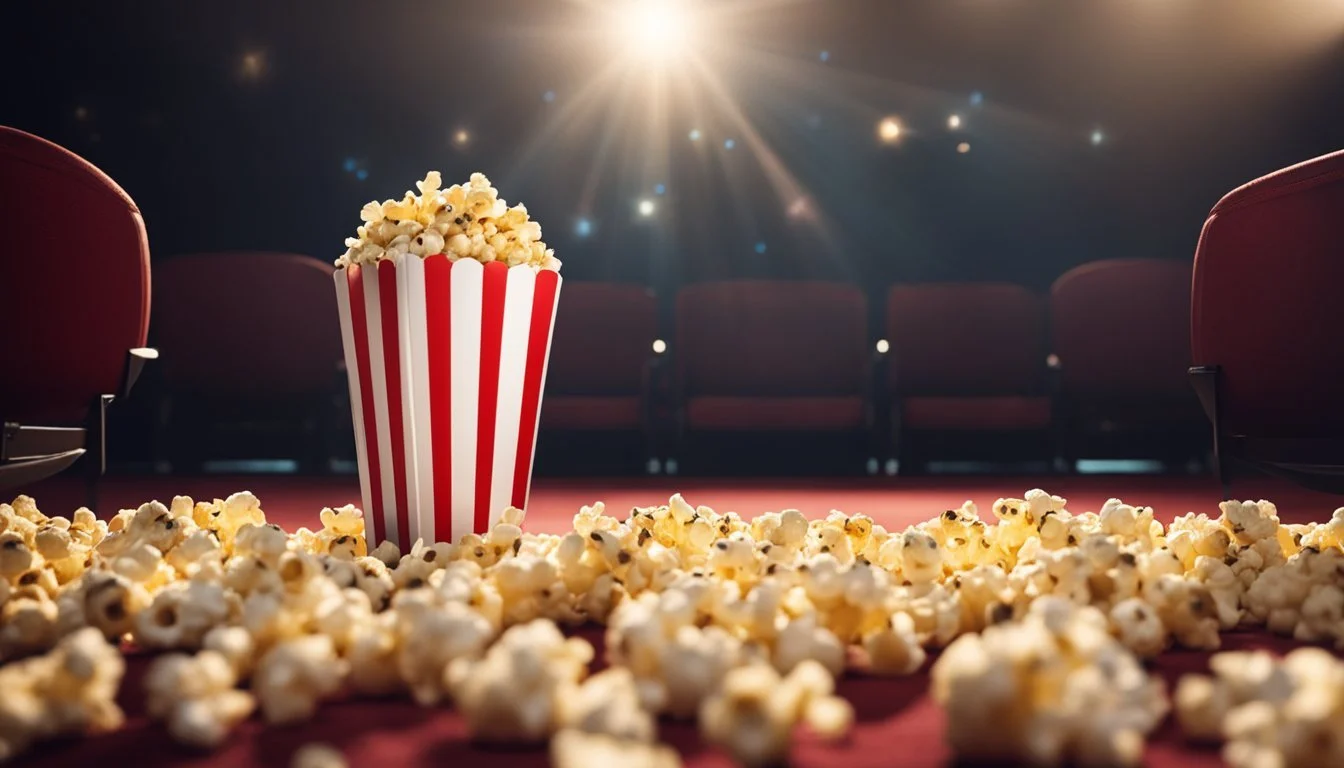The Power of Subtext
Mastering Implication in Cinematic Storytelling
In the realm of cinema, the art of subtext is a powerful tool that transforms simple dialogue and scenes into multi-layered narratives. Subtext allows filmmakers to convey complex emotions and themes through implication rather than direct exposition, engaging audiences on a deeper level. This subtle technique can make the difference between a good film and a great one.
Subtext works beneath the surface of the story, using visual and auditory cues, actor performances, and meticulously crafted dialogue. By leveraging these elements, directors and writers provide viewers with a richer, more immersive experience that invites further reflection and analysis.
Cinematic subtext not only enhances storytelling but also fosters a more active and emotionally resonant connection with the audience. It invites viewers to read between the lines, discover hidden meanings, and appreciate the intricate craftsmanship involved in film-making.
Unpacking Subtext: Definition and Significance
Subtext adds layers of meaning to a narrative by embedding unspoken implications beneath the dialogue and actions of characters. This technique elevates the storytelling, fostering deeper engagement and richer audience interpretation.
Subtext in Storytelling
Subtext operates beneath the surface dialogue, offering a concealed layer of meaning that enhances the narrative. For instance, a simple exchange about the weather can signify tension between characters if the delivery and context indicate underlying conflict.
In classic literature and modern film alike, subtext helps illustrate complex relationships without direct statements. By employing subtext, creators can shape more intricate and immersive worlds. Subtext becomes a potent tool in crafting multi-dimensional characters and plots.
Examples of subtext are prevalent in works like "The Great Gatsby," where seemingly casual conversations carry deep emotional and thematic weight. Similarly, in films such as "Inception," subtext helps drive the narrative forward, providing clues to the characters' true motivations and feelings.
Subtext vs. Text: Understanding the Distinction
While text refers to the explicit content of dialogue and description, subtext conveys the implicit messages that lie beneath. Text is what the audience reads or hears directly; subtext represents the hidden meanings that enrich the narrative.
A key distinction is that text is explicit and overt, meant to advance the plot and convey direct information. In contrast, subtext remains covert and subtle, requiring the audience to infer deeper meanings and emotional undercurrents.
Recognizing this distinction allows creators to manipulate audience perception more effectively. For example, a character might say, "I'm fine," but the subtext, revealed through a quivering voice or averted gaze, suggests they are actually distressed. Understanding this difference is crucial in analyzing and crafting nuanced, layered stories.
Mechanisms of Implication in Film
Films convey deeper meanings through visuals, sounds, and dialogue. Each mechanism works differently but collectively enriches storytelling.
Visual Subtext: Show, Don’t Tell
Visual subtext uses imagery to convey underlying themes without direct exposition. Filmmakers utilize color palettes, lighting, and framing to represent characters’ internal states or thematic undercurrents. For example, in "The Shawshank Redemption," the use of light and shadow illustrates hope and despair. Symbols such as caged birds or broken mirrors often represent freedom and fragmented identities. By using these visual cues, directors invite viewers to engage actively, deciphering the implicit meanings layered within the film’s visuals.
Auditory Subtext: The Power of Sound
Sound design and music serve as powerful tools for subtext. Composers and sound designers can subtly influence the audience’s emotions and perceptions. For instance, a melancholy score underlines a seemingly happy scene, adding depth and irony. Ambient sounds, like an off-screen storm, might symbolize internal turmoil. The use of diegetic and non-diegetic sounds creates layers of meaning. In "Inception," the soundtrack’s tempo hints at the dream layers' complexity. Sound bridges can also connect scenes, carrying emotional or thematic threads across different parts of the narrative.
Dialogue-Driven Subtext: Reading Between the Lines
Dialogue-driven subtext occurs when the true meaning lies beneath the spoken words. Characters may use sarcasm, understatement, or double entendres to convey hidden sentiments. In "Pulp Fiction," conversations often have multiple layers, revealing character motivations indirectly. Pauses and silences in dialogue are equally significant, adding tension and revealing unspoken thoughts. The interplay between what is said and what remains unsaid forces the audience to read between the lines, interpreting the characters' deeper psychological and emotional states through their dialogue.
Analyzing Subtext in Iconic Films
Subtext in films can convey emotions, character motivations, and complex themes. This section explores how silence, cinematography, and character development utilize subtext to enhance storytelling.
Case Study: The Use of Silence
Silence often speaks louder than words in iconic films. In The Godfather, moments of silence create tension and highlight character decisions. For instance, the famous scene where Michael Corleone decides to take revenge is marked by a heavy, contemplative silence, underscoring his internal conflict and resolution.
Similarly, No Country for Old Men uses silence to build suspense. The lack of dialogue in many scenes, especially between the protagonist and antagonist, magnifies the intensity of their encounters. Silence thus becomes a powerful tool for directors to express unspoken thoughts and emotions.
Symbolism and Metaphor in Cinematography
Cinematography can incorporate subtext through visual metaphor and symbolism. In Blade Runner, the recurring motif of rain symbolizes the blurred lines between humanity and artificiality. The use of shadows and light in film noir aids in symbolizing moral ambiguity and hidden truths.
Pan’s Labyrinth uses color schemes to symbolize innocence and corruption. The fantasy world’s vibrant colors contrast with the grim reality of post-Civil War Spain, emphasizing themes of escapism and resistance. Visual elements like these embed deeper meanings within the frame, guiding the viewer’s subconscious interpretation of the narrative.
Character Development and Subtextual Layers
Character arcs are enriched by subtextual layers that reveal deeper motivations and conflicts. In Breaking Bad, Walter White's transformation is subtly conveyed through his changing attire and mannerisms, hinting at his moral descent.
The Shawshank Redemption employs subtext to deepen character relationships. Red’s initial hesitation and eventual acceptance of Andy mirror his journey towards hope. Small, everyday interactions, such as a shared look or gesture, often carry significant emotional weight, illustrating the unspoken bond between characters.
Breaking down these elements helps to appreciate how subtext operates on various levels, enhancing the viewing experience. These techniques demonstrate how filmmakers craft complex, resonant narratives that engage audiences beyond the explicit storyline.
The Role of the Audience: Interpretation and Perception
Audience interpretation of subtext plays a pivotal role in how films are understood. Each viewer brings unique experiences and perceptions that influence their reading of the underlying meanings.
Engaging the Viewer: The Active Role of Interpretation
Subtext thrives on the active engagement of the audience. Rather than just passively consuming content, viewers decode and interpret the hidden messages.
This engagement makes the film-watching experience interactive and personal. Directors often use visual cues, dialogue nuance, and symbolism, requiring audiences to read between the lines.
This process involves analyzing character behavior, setting, and even costumes, as each element may carry deeper significance. The active role in interpretation transforms the viewer from a passive recipient to an integral participant in the narrative construction.
The Subjectivity of Subtext
Interpreting subtext is inherently subjective. Different eyes see different layers of meaning based on individual backgrounds and perspectives.
This subjectivity makes each viewing experience distinct. One viewer may catch subtle emotional cues while another might focus on societal implications.
Such varied interpretations are what make discussions about films rich and diverse. Filmmakers leverage this by crafting layered narratives that resonate differently with various segments of the audience, ensuring a more immersive and thought-provoking experience.
The Filmmaker's Toolbox: Crafting Subtext
Creating subtext in film involves a range of techniques that go beyond dialogue. Filmmakers rely on scriptwriting, direction, and editing to subtly convey deeper meanings and emotions.
Scriptwriting Techniques for Subtext
Subtext begins with the script. Writers use indirect dialogue and meaningful silences to imply unspoken thoughts, emotions, and conflicts.
Indirect Dialogue: Characters may talk about one subject while implying another. For example, a couple discussing the weather might reveal tensions about their relationship.
Meaningful Silences: Sometimes, what is not said is more telling. A pause or an unfinished sentence can carry significant weight.
Subplots: Secondary storylines can mirror or contrast the main plot, providing additional layers of meaning.
Directional Strategies for Subtextual Storytelling
Directors use visual and auditory elements to weave subtext into the film’s fabric. These strategies include visual composition, actor performances, and sound design.
Visual Composition: Camera angles, lighting, and framing convey subtext. A close-up shot can reveal a character's hidden emotions.
Actor Performances: Subtle gestures and facial expressions are crucial. An actor's nuanced performance can communicate what words cannot.
Sound Design: Background sounds and music often carry symbolic meanings. A recurring melody might signify unspoken longing or fear.
Editing Choices That Enhance Subtext
Editors play a pivotal role in ensuring that the subtext is effectively communicated through the final cut. This involves careful selection and arrangement of scenes, pacing, and the use of visual motifs.
Scene Selection: Choosing which scenes to include or omit can shift the audience's perception. Implied actions off-screen often create a deeper context.
Pacing: The rhythm of a film influences its emotional tone. A slower pace might emphasize the weight of unspoken words or unresolved tension.
Visual Motifs: Recurrent images or themes can subtly reinforce subtext. For instance, showing a particular object repeatedly might hint at a character’s obsession or hidden fears.
Challenges and Pitfalls of Using Subtext
Subtext can enrich narratives and convey deeper meanings, but it also presents specific challenges. Writers must avoid making the subtext too obscure and must balance subtle nuances with clear, on-the-nose narrative elements.
Avoiding Overly Obscure Subtext
If subtext is too subtle, the audience may miss it entirely. Readers or viewers might not grasp the intended depth or underlying message, leading to confusion or misinterpretation.
Writers should provide enough context clues. Symbols and metaphors should be clear enough to guide the audience without unnecessary vagueness.
Feedback from test audiences can be invaluable. Their reactions can pinpoint places where subtext is too hidden, prompting necessary adjustments.
Balancing Subtext with On-The-Nose Narrative
An effective story balances subtext with explicit dialogue and action. Too much reliance on subtext can bog down the narrative, making it feel insubstantial.
Direct narrative elements are crucial. They provide a foundation upon which subtext can build, offering clarity and structure. A mix ensures that the audience remains engaged without feeling lost.
Techniques like juxtaposing subtext against direct statements help in this balance. This contrast allows the audience to appreciate the layers of meaning without becoming overwhelmed by subtext alone.
Subtext in Genre Films vs. Art Cinema
Subtext serves as a powerful tool in both genre films and art cinema, though its application and impact often differ significantly between the two.
The Treatment of Subtext in Different Genres
Genre films, such as action, horror, and romance, frequently utilize subtext to enhance character development and plot dynamics. Such subtext can be found in visual cues, thematic elements, or character interactions. For example, in action films, underlying themes of heroism and sacrifice might emerge through character choices and symbolic imagery.
In horror, subtext often explores societal fears and psychological depths through metaphorical monsters or settings. Romance films use subtext to convey unspoken emotions and conflicts. The heavy reliance on genre conventions means subtext must be accessible and easily interpretable by a wide audience.
Subtextual Elements in Mainstream vs. Niche Films
Mainstream films generally aim for broad appeal and utilize subtext in ways that complement the primary storyline without overshadowing it. Visual and auditory elements, such as costume choices or background music, subtly enrich the narrative. For instance, superhero films might use color symbolism or iconic motifs to suggest deeper themes of justice or identity.
In contrast, art cinema delves into more complex and layered subtext. Directors like Stanley Kubrick or David Lynch embed intricate and often ambiguous subtext, encouraging viewers to engage in deeper analysis. These films rely on visual symbolism, nuanced performances, and sparse dialogue to convey meaning, often leaving much to individual interpretation.
Art films challenge the audience to look beyond the surface, creating a more immersive and intellectually engaging experience.
Conclusion: The Enduring Impact of Subtext in Film
Subtext remains an essential narrative tool in film. It enriches storytelling by providing layers of meaning beneath the surface dialogue and actions. Filmmakers use subtext to create deeper emotional connections and to engage audiences on multiple levels.
The skillful use of subtext allows for nuanced character development. Characters become multi-dimensional when their unspoken thoughts and emotions are conveyed through implication. This technique adds realism and complexity.
Subtext also enhances thematic expression. Films can address complex themes subtly and powerfully. By not explicitly stating themes, filmmakers invite viewers to think critically and engage more deeply with the narrative.
Audiences appreciate films with well-executed subtext because it adds a sense of discovery. Interpreting subtextual elements can be a rewarding experience, making films more memorable and thought-provoking.
Subtext can reveal hidden relationships and conflicts. It sharpens the storytelling by providing insights into characters' motivations and desires, which might not be articulated directly. This leads to richer narratives.
The legacy of subtextual films includes classics that continue to inspire and influence new generations of filmmakers. Subtext is timeless and adaptable, ensuring its place in the future of cinematic storytelling.
Incorporating subtext demands precision and creativity from filmmakers. Those who master subtext can convey profound stories that resonate emotionally and intellectually.




